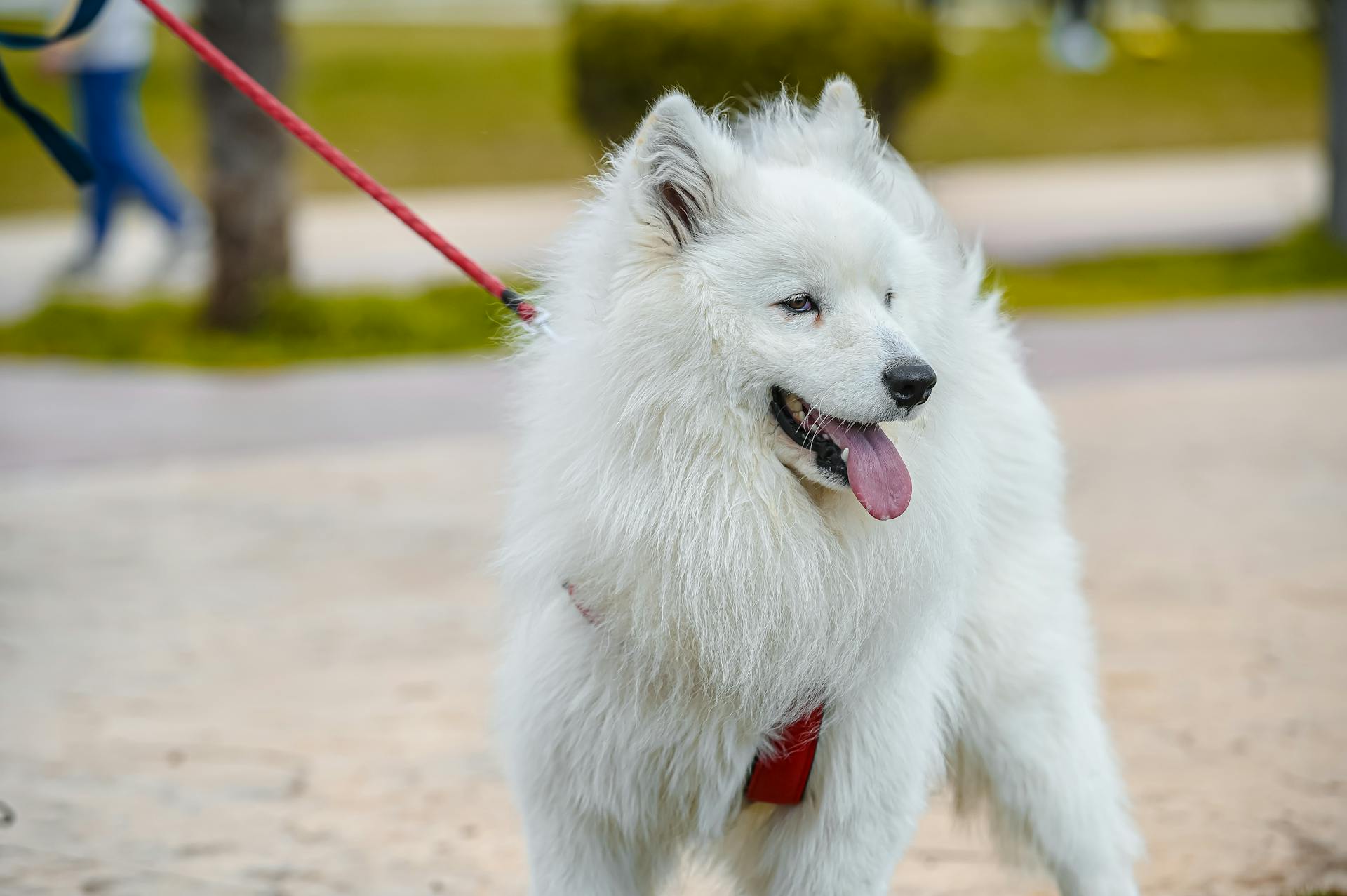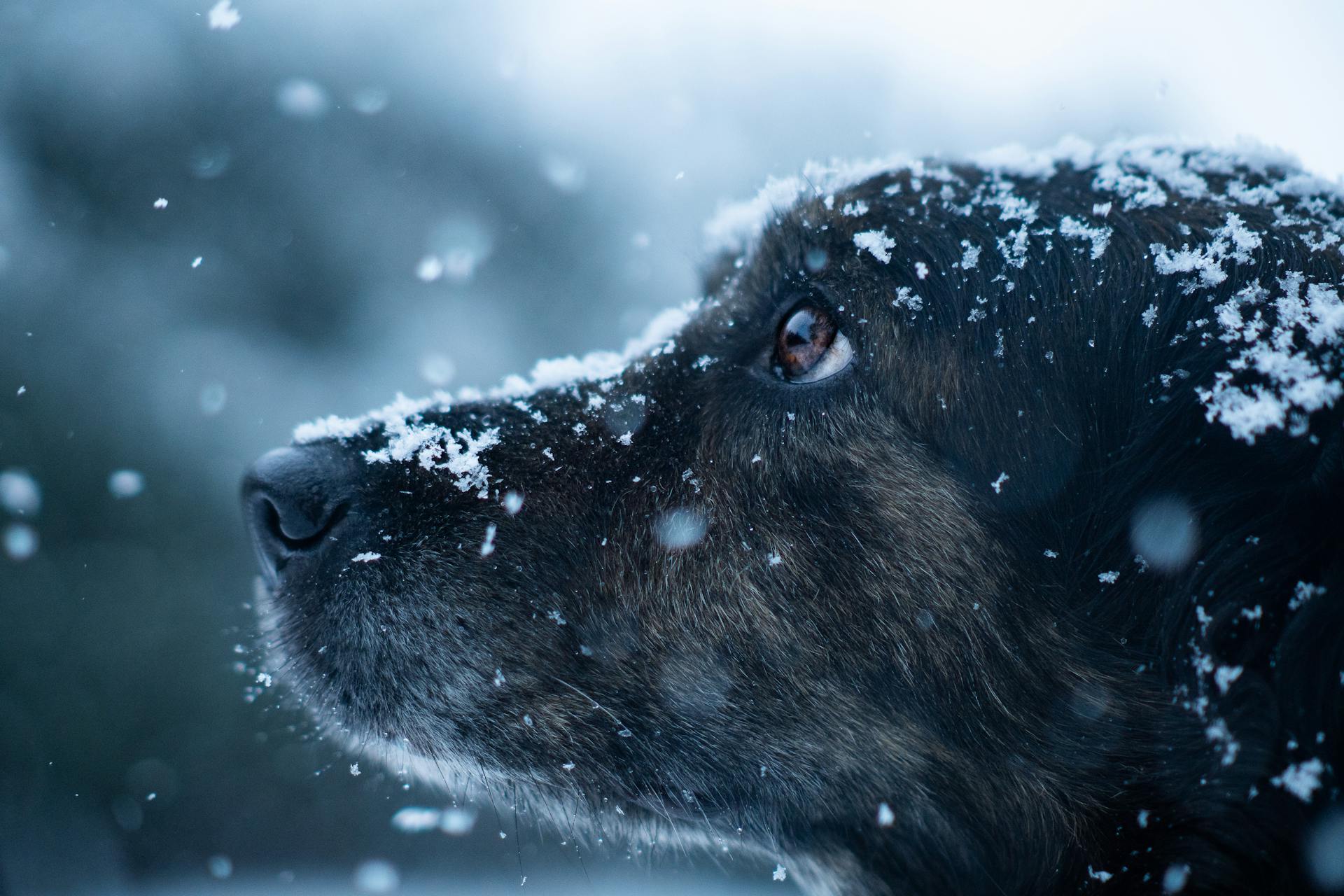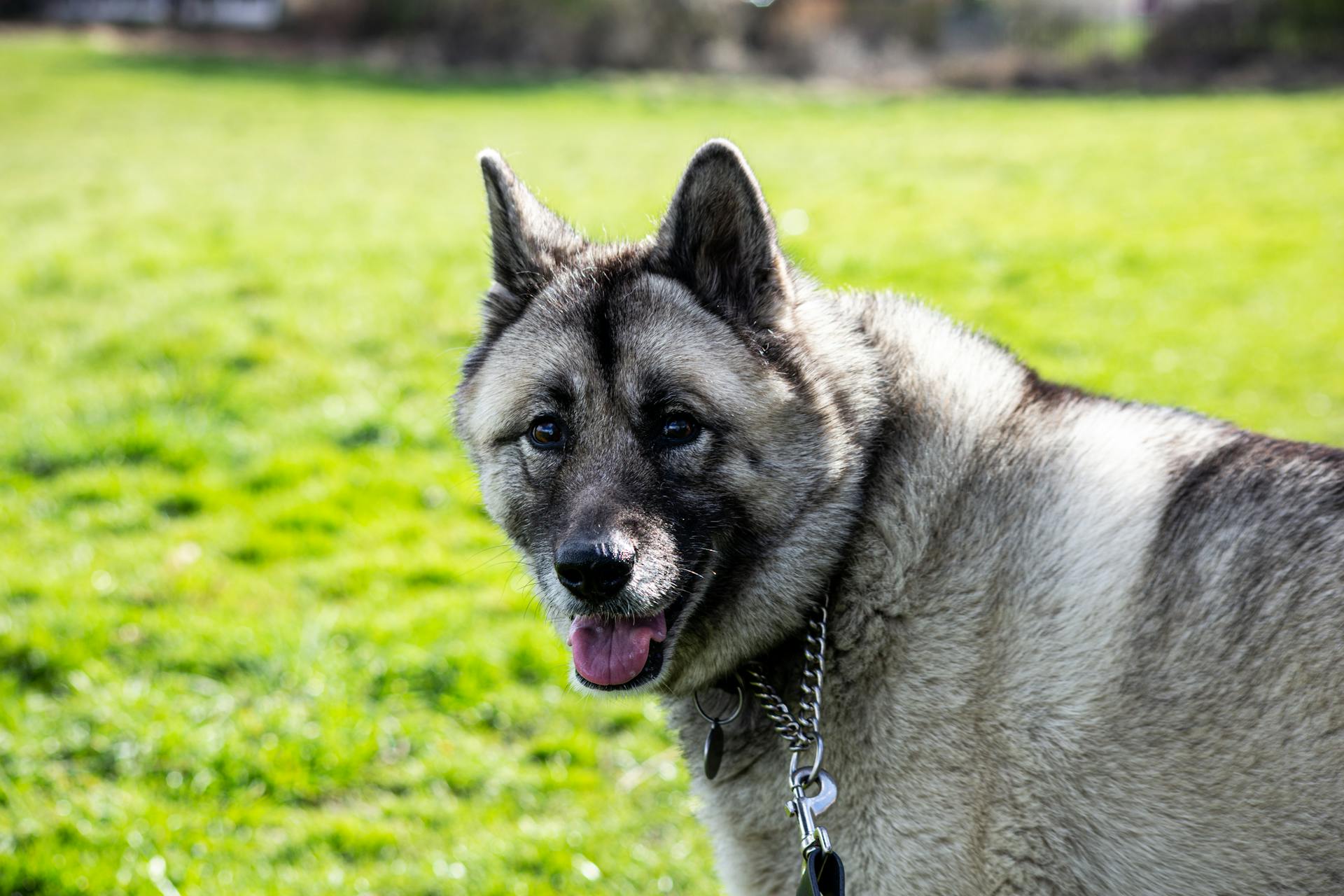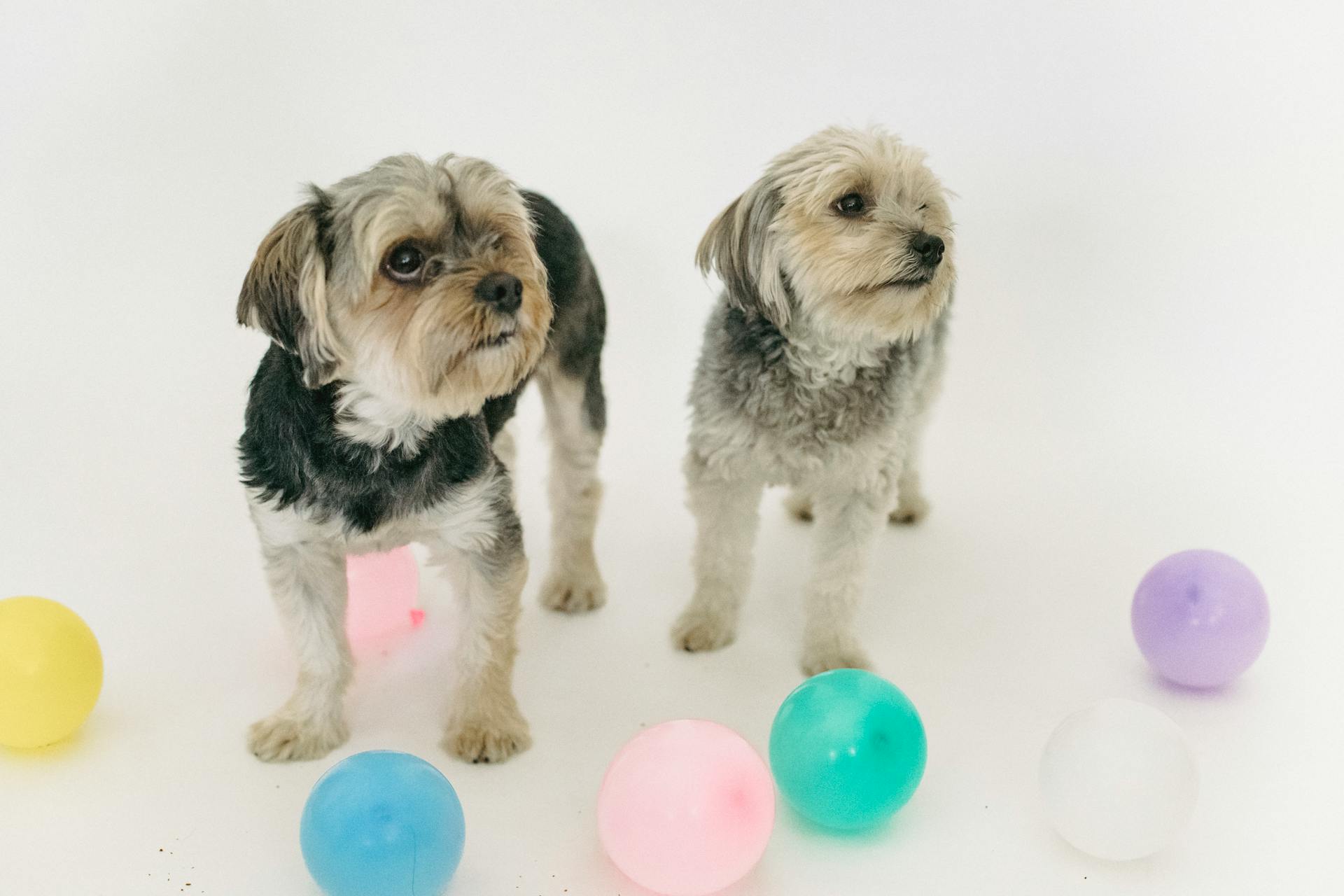
The Norwegian Lundehund is a unique and fascinating breed with a rich history. Originating from the Lofoten Islands in Norway, this small dog was bred to hunt and climb cliffs to catch small game like puffins and other seabirds.
One of the most distinctive features of the Norwegian Lundehund is its six-toed paws, which allow it to climb and perch with ease. This adaptation is a testament to the breed's original purpose.
In terms of size, Norwegian Lundehunds are relatively small, weighing between 13-15 pounds and standing between 12-15 inches tall at the shoulder. This compact size makes them well-suited for life in small spaces.
With proper care and attention, Norwegian Lundehund puppies can thrive and become loving companions.
Origin & History
The Norwegian Lundehund is a spitz dog that originated on remote islands of arctic Norway.
The breed has been found in Lofoten, an archipelago of Norway, for centuries, where it played a crucial role as a working animal in hunting puffin birds along the Norwegian coast for over four centuries.
The first known written record of the breed dates back to 1591, when a bailiff described the use of a small dog to retrieve puffins from deep holes.
The Norwegian Lundehund was specifically bred by the locals for hunting its namesake, the puffin, which is a common sight around cliffs where it forms a breeding colony between April and early to late September.
Its remarkable flexibility and extra toes made them well-suited for accessing the birds' inaccessible nesting locations on cliffs and in caves.
The breed's numbers declined when new methods of using nets for hunting puffins were incorporated and a dog tax was created, and by the early 1900s, Lundehunds could only be found in the isolated village of Mostad in Lofoten.
The breed was nearly extinct around World War II when canine distemper struck Værøy and the surrounding islands, reducing the population to just two dogs.
Careful breeding and adherence to strict guidelines helped the Lundehund population gradually recover, and as of 2022, there are an estimated 1,500 Lundehunds worldwide, with approximately 900 of them residing in Norway.
The breed's unique characteristics, such as its extra toes, make it a valuable and rare breed, especially outside of its native country.
The Norwegian Lundehund entered the American Kennel Club's foundation stock service in 1996 and was recognized as an official breed in 2011.
Curious to learn more? Check out: When Is It Best to Breed a Female Dog
Breed Characteristics
The Norwegian Lundehund is a small, rectangular Spitz type dog with a unique range of motion in its joints, allowing it to fit into and extricate itself from narrow passages and tunnels.
Their flexibility is quite remarkable, as they can bend their head backwards along their own spine, similar to the New Guinea singing dog, Bornean dingo and Australian dingo, and turn their forelegs to the side at a 90-degree horizontal angle to their body, much like human arms.
They have six toes per foot, which is a polydactyl trait, and their ears can be folded shut to form a near-tight seal by folding forward or backward, protecting them from dirt and parasites.
Their outercoat is dense and rough with a soft undercoat, and they are adapted to climb narrow cliff paths on the island of Værøya where they originally would have hunted puffins.
The Lundehund is an active breed that requires a fair amount of exercise, making them a great companion for families who enjoy outdoor activities.
They generally have an alert but friendly temperament, and typically don’t have an overly affectionate personality, but they do enjoy being active with their owner.
Their flexibility allows them to wiggle their ears and close the canal completely if needed, and they can also bend their heads to touch their backs and spread their front legs to the side.
Health and Care
The Norwegian Lundehund is a relatively healthy breed, but like all purebreds, they can be prone to some health problems.
Regular veterinary care is crucial, especially since their unusual physiology can make them more susceptible to certain diseases. Intestinal Lymphangiectasia (IL) and Lundehund Syndrome are two conditions that can cause a range of symptoms, including weight loss, vomiting, and diarrhea.
Some common health issues in Norwegian Lundehunds include hip dysplasia, eye problems, and Patellar Luxation. They're also prone to Von Willebrand's disease, which affects blood clotting.
Here are some health problems to be aware of:
- Hip dysplasia
- Eye problems
- Patellar Luxation
- Von Willebrand's disease
It's essential to have your Norwegian Lundehund regularly screened for these health problems and to work with a reputable breeder who prioritizes the health of their dogs.
Health Issues

The Norwegian Lundehund is a generally healthy breed, but they can be prone to some health problems.
Hip dysplasia is a condition in which the hip joint doesn't fit together properly, causing pain and lameness.
Eye problems are common in Norwegian Lundehunds, including cataracts, glaucoma, and retinal dysplasia.
Lundehund syndrome is a rare condition that affects the lymphatic system, causing weight loss, swelling, and lethargy.
Von Willebrand's disease is a blood clotting disorder that can cause excessive bleeding.
Regular veterinary check-ups are essential to detect any health issues early on.
Here are some common health problems that can affect Norwegian Lundehunds:
- Patellar luxation
- Eye problems
- Gastrointestinal problems
Lundehund syndrome can cause intermittent diarrhea, vomiting, weight loss, and ascites, and it's essential to manage the disease to prevent poor quality of life.
A low-fat and higher-protein diet has been shown to have positive effects on digestive problems in Norwegian Lundehunds.
Feeding
Feeding your Norwegian Lundehund requires attention to their nutritional needs, age, activity level, and individual preferences. Choose a high-quality dog food with real meat as the primary ingredient and avoid excessive fillers and artificial additives.

Puppies, adults, and seniors have distinct nutritional needs, so determine the appropriate portion size based on your dog's age and activity level. Maintain a consistent feeding schedule, typically offering two meals a day for adults, with puppies requiring more frequent meals.
Norwegian Lundehunds are prone to obesity, so monitor your dog's weight and adjust their food intake as needed. Keep treats and snacks limited, choosing healthy, low-calorie options that don't exceed 10% of their daily caloric intake.
Always provide fresh and clean water to keep your Lundehund adequately hydrated. Regular veterinary check-ups are essential to assess your dog's overall health, nutritional needs, and weight management.
Commercial diets are the easiest to feed and contain all necessary nutrients, but if you prefer to feed a homemade diet, consult your veterinarian first to ensure it's correctly balanced.
See what others are reading: English Mastiff Adults
Grooming
The Norwegian Lundehund's grooming needs are relatively straightforward. They have a double coat that sheds quite a bit, so be prepared for daily brushing sessions to keep the shedding under control.
Their coat is made up of a soft and dense undercoat with a robust outer coat, which keeps them warm in cold climates. A weekly brushing will keep their coat clean and free of dirt.
Make sure to check their ears at least weekly for any debris, wax buildup, and irritation. Regular nail trims are also a must to prevent overgrowth.
The Lundehund's coat typically stays relatively clean, so a bath is only needed roughly once a month. However, during periods of higher shedding, you may need to brush their coat daily to keep up with all the loose fur.
Daily brushing sessions will also help prevent matting, especially during periods of higher shedding in the spring and fall.
See what others are reading: Shiba Inu One Cent
Temperament and Suitability
The Norwegian Lundehund is a protective breed that will alert their owners to any intruders, making them excellent watchdogs.
They are known to be kind and sociable to their owners, but can be apprehensive around strangers, so early socialization is crucial.
Expand your knowledge: Shiba Inu Owner
As a hunting breed, Norwegian Lundehunds are active and energetic, requiring a medium to large area to play or exercise.
They are easy to train, but can be challenging due to their moody nature.
Norwegian Lundehunds are considered loners and require little attention, making them a great choice for families who want a low-maintenance pet.
They are kid-friendly and can be a good pet for families with children, but supervision is necessary around younger kids who may not know how to handle them gently.
This breed is sensitive and doesn't tolerate harsh or rough training, so gentle and patient training is necessary.
They are intelligent dogs that can be trained to become sociable, but may grow up cautious and fearful if not exposed to other animals and people as puppies.
Norwegian Lundehunds are generally good with kids, but may not accept rough play from toddlers, making them a great choice for families with older, more active kids.
They can be a bit noisy, so families who live in apartments or similar housing may not be the best fit for this breed.
With early and frequent socialization, shyness can be avoided, making them a great choice for families who want a loyal and protective pet.
Training and Exercise
Training and exercise are crucial for Norwegian Lundehund puppies. They require a lot of exercise, with daily walks being a must.
You'll want to plan for at least 30 minutes of exercise daily, which can include a power walk, jog, or active play session. A home with a fenced-in yard is ideal, but keep an eye out for holes in the fence as they love to dig.
Lundehunds are intelligent problem-solvers, but they can be independent and stubborn at times. Positive-reinforcement training methods like treats and praise work well, but harsh corrections should be avoided.
Exercise
Exercise is a must for Norwegian Lundehunds, requiring daily long walks on a schedule.
These dogs need at least 30 minutes of exercise daily, which can be a power walk, jog, or active play session.
Their medium-high energy level means they can get bored if they don't get enough physical activity, so it's essential to keep them engaged.

A home with a fenced-in yard is ideal for the active Lundehund, but be sure to check for holes in the fence, as they love to dig.
If you don't provide enough exercise and mental stimulation, your Lundehund might engage in problem behaviors like unwanted chewing.
To prevent this, plan to give your dog at least one to two hours per day of exercise via walks, jogging, hiking, and vigorous play.
Training
Training your Norwegian lundehund from a young age is crucial for its well-adjusted development.
This breed typically does well with positive-reinforcement training methods, such as treats and praise, which encourage good behavior without scolding.
Lundehunds can be sensitive to harsh corrections, so it's essential to avoid them to prevent shutting down and refusing to learn.
Training sessions should be fun and varied to keep your lundehund's interest and prevent boredom.
Exposing your lundehund to other people and dogs from an early age is also vital, as this breed can be wary of strangers and may need time to build comfort and confidence.
Frequently Asked Questions
How much does a Norwegian Lundehund cost?
A Norwegian Lundehund typically costs around $2000, making it a relatively expensive purebred dog.
Are Norwegian Lundehund good pets?
Norwegian Lundehunds make great pets for many owners, offering a balanced and affectionate companionship
Why are Norwegian Lundehund so rare?
Norwegian Lundehunds became rare due to a combination of factors, including their decreasing usefulness as puffin catchers and the imposition of taxes by the government. This led to a significant decline in their population and made them a rare breed.
Do Norwegian Lundehund bark?
Norwegian Lundehunds are prone to barking, especially at new sights and sounds. They require consistent training to learn when to bark and when to be quiet.
What is special about a Norwegian Lundehund?
The Norwegian Lundehund is known for its unique physical characteristics, including extra toes and flexible joints, as well as its distinctive movable ears. Its most notable feature, however, is its exceptionally mild and even-tempered personality.
Featured Images: pexels.com
